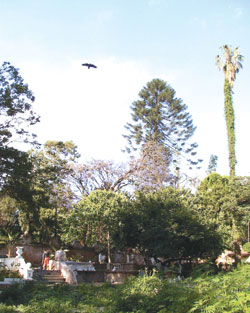 If inspecting the progress of the restoration of the garden and exploring the antiquated library weren't already incentive enough to visit Keshar Mahal, then surely looking up at the resident cattle egrets that have returned to nest will be.
If inspecting the progress of the restoration of the garden and exploring the antiquated library weren't already incentive enough to visit Keshar Mahal, then surely looking up at the resident cattle egrets that have returned to nest will be. The trees in Keshar Mahal's enchanted garden are once again busy with the squawks and nest-building of the beautiful and elegant egrets. Every year, about 1,000 of these snow-white birds with gold breeding plumes nest en masse, sharing the trees opposite the royal palace with large fruit bats.
Although this small haven nestled beside busy Kantipath and Thamel would seem one of the worst areas in the city for nesting, it does have some advantages. The lack of natural predators combined with the inactivity on the grounds of the Education Ministry ensures a disturbance-free ground space for the many vulnerable fledglings that undoubtedly fall to the ground on their first flight. Over two hundred young birds have been observed hopping around during recent weekends.
Keshar Mahal's trees are also ideal for the clumsy and painfully awkward landings and nest-building habits of the egrets. Pride of India, cedars, magnolias and mulberry trees provide relatively open flight paths and easy, horizontal branches to land on, and such branches are also easy to build nests on.
The best-suited nesting trees in Keshar Mahal become densely packed with these loosely constructed nests. One Pride of India tree last year had 62 active nests. The male collects sticks and twigs-often stealing from neighbouring nests-while the female builds. Chicks hatch in late May and by July are ready to start flying. Often at this time, adults with young can be seen on Tundhikel as part of their flight training. By late August, with the monsoon in full swing, Keshar Mahal is deserted and the fledglings travel with their parents to the rivers and paddy fields on the city's outskirts. Although not dependent on cattle, a major food source of the egrets are the insects and small animals stirred up by cows, buffaloes and other large herbivores as they walk in grass, which is why they follow livestock around.
 Globally, the cattle egrets are an anomaly in this period of human-caused species extinction-they are one of the few birds widening their range. Originally from Africa, they have rapidly colonised Asia and island-hopped through South East Asia to Australia and New Zealand. A flock of egrets was blown across the Atlantic to the coast of South America in the 1870s, and quite probably from this one flock have spread across all of the tropical and subtropical Americas up into the United States.
Globally, the cattle egrets are an anomaly in this period of human-caused species extinction-they are one of the few birds widening their range. Originally from Africa, they have rapidly colonised Asia and island-hopped through South East Asia to Australia and New Zealand. A flock of egrets was blown across the Atlantic to the coast of South America in the 1870s, and quite probably from this one flock have spread across all of the tropical and subtropical Americas up into the United States. Their successful dispersion is due largely to the rapid cutting of forests and expansion of grasslands for cattle in the last century and their ability to adapt to situations ranging from the plains of Africa to the less-than-pristine urban Kathmandu.
Hopefully, the egrets will adapt to the restoration work and subsequent increased human presence in the gardens below them. The restorers for their part aren't too thrilled with the idea of 1,500 birds each year will be dropping guano near or on the tables of their planned restaurant inside the garden. But the unique Keshar Mahal garden is also a special treasure that deserves to be preserved with a little flexibility in the restoration design, the egrets can be incorporated into and enhance the gardens for their four nesting months.
Another more selfish argument for the egrets is that they provide a tranquil sight in the midst of evening rush-hour traffic. Just the surreal and calming beauty of their holding pattern over the din and traffic of Kantipath as they wait to land make them more than a worthwhile addition to the city's biodiversity. Show your support by visiting Keshar Mahal with your binoculars and looking up at the branches to catch a sight of the young chicks in their nests.


